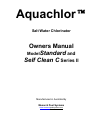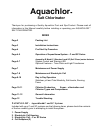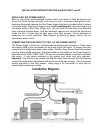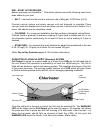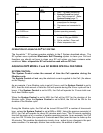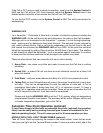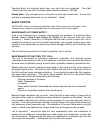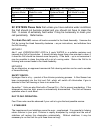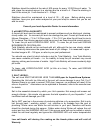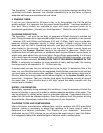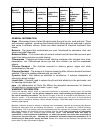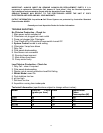10
The Aquachlor unit has a built in warning system to minimise damage resulting from
insufficient salt levels, however, the ultimate responsibility is on the owner to ensure
adequate salt levels are maintained all year round.
4. RUNNING TIMES:
If you run your chlorinator for 24 hours a day, or for long periods, the Cell life will be
greatly reduced. It is important that the correct model Aquachlor has been installed on
your pool. Many models are available to cope with small courtyard pools up to
commercial applications. (Consult your local Aquachlor Dealer for more information).
CHLORINE PRODUCTION:
The Aquachlor unit must be run daily to generate sufficient chlorine to sanitise the
pool. During Summer this is approximately eight hours per day, preferably in two periods
- between 6.00 and 8.00am and between 5.00 and 11.00pm. Night time is preferable
because chlorine dissipates rapidly in direct sunlight. If these running times are
observed, and the Cell is functioning correctly, your pool will have sufficient chlorine
when tested in the morning. If the level is too low either longer running times are
required or the System Control needs to be adjusted to maximum. Harsh local
conditions such as traffic pollution or windborne dust require different running times, in
which case, seek advice from your pool shop. During Winter approximately 4 to 6 hours
a day should provide enough chlorine. Without sufficient filtration/chlorination, your pool
will never function correctly. ALWAYS RUN THE FILTER WHEN SWIMMING IN THE
POOL. In extremely hot weather or during periods of heavy bathing loads, the running
time may need to be extended to 10 - 14 hours per day.
In some cases you may find your chlorine level to be too high. To determine if this is the
case, run your filter/chlorinator for the suggested times/chlorine production level and test
your pool water on the morning after operation. If your chlorine test shows a high level of
chlorine, either the running times can be reduced slightly, or the System Control can be
turned anti - clockwise. Test your chlorine level again the following morning at around
the same time. If your chlorine level is still high, repeat the above process until the
correct level is attained.
SUPER - CHLORINATION:
Periodically, especially during extremely hot conditions, it may be necessary to boost the
amount of chlorine in your pool in order to maintain absolute sanitation of the water. This
can be achieved by adding either liquid or granulated chlorine. If granulated chlorine is
added, the Cell must be checked regularly, since the additives from this product will clog
the electrodes. Alternatively, extend the running time of your Aquachlor.
CHLORINE TYPES AND COMPARISONS:
Many chlorinator manufacturers calibrate their units to compare with 65% granulated
chlorine, making it necessary to adjust their readings to a lower level in order to
determine true chlorine production. The Display on your Aquachlor expresses
production as pure 100% chlorine so you will know the exact output of your Unit. Below
is a comparison table of the available types of chlorine used to sanitise pools.



